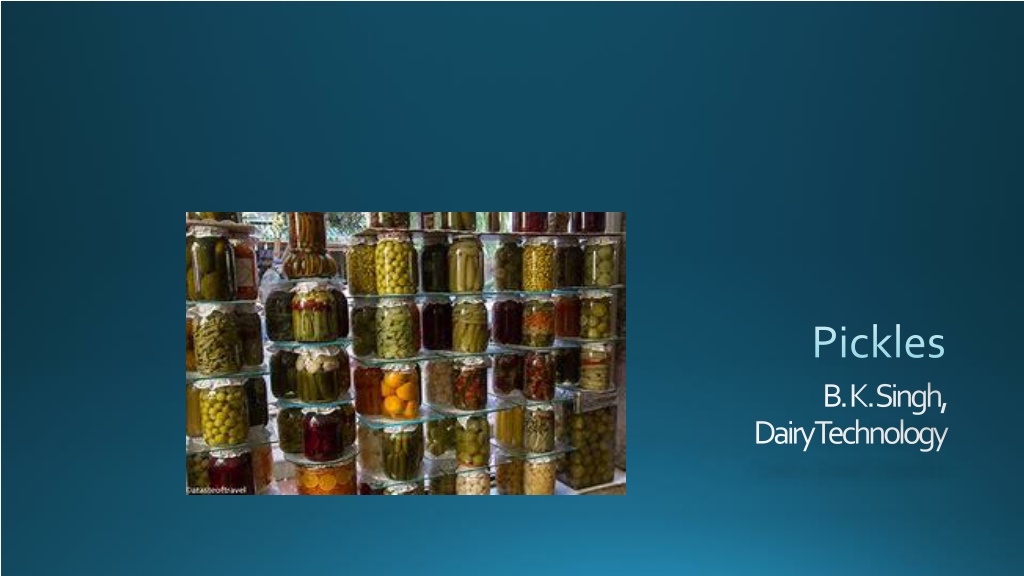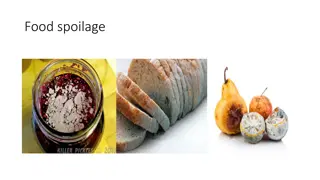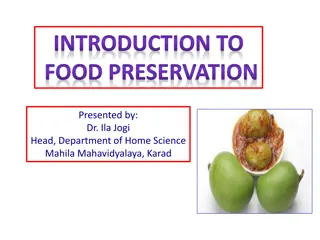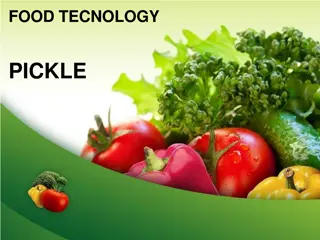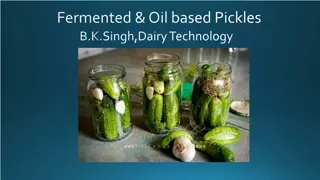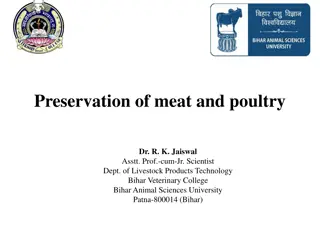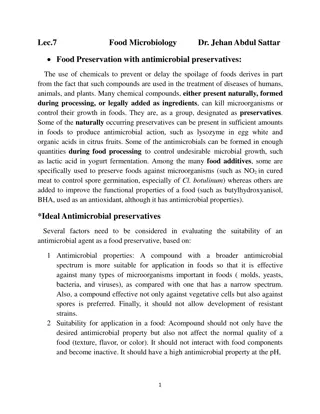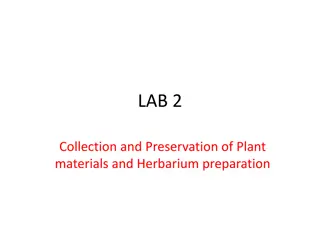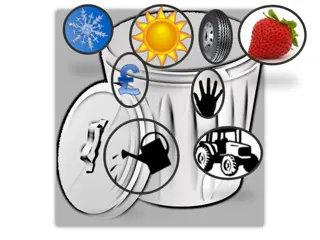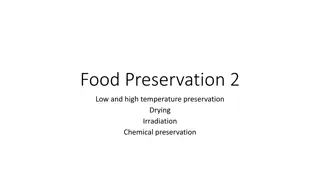All About Pickles: Types, Preservation, and Spoilage
Pickles, a beloved food item known for their unique taste and variety, are an essential part of many cuisines around the world. This article explores the different types of pickles, methods of preservation using common preservatives like salt and vinegar, as well as signs of spoilage to watch for. From oil-based pickles to fermented varieties, learn about the rich diversity of pickles and how they are made.
Download Presentation

Please find below an Image/Link to download the presentation.
The content on the website is provided AS IS for your information and personal use only. It may not be sold, licensed, or shared on other websites without obtaining consent from the author. Download presentation by click this link. If you encounter any issues during the download, it is possible that the publisher has removed the file from their server.
E N D
Presentation Transcript
Pickles B. K. Singh, Dairy Technology
Pickle Pickles or achaar are unique because these are mixed with spices that only India produces. Some common Indian spices include cumin, mustard seeds, fenugreek, turmeric, coriander, etc. Some of the typical Indian pickles made from mango (aam ka achaar), lime (nimbu ka achaar), turnip, cabbage, cauliflower, etc. have become popular in several countries
Definition In India, the Food Safety and Standards (FSS) Rules (2006) defines pickles as preparation made from fruits and vegetables or other edible plant material including mushrooms free from insect damaged or fungal infection, singly or in combination preserved in salt, acid, sugar or any combination of the three. The pickle may contain onion, garlic, ginger, sugar, jaggery, edible vegetable oil, green or red chillies, spices, spice extracts/oil, lime juice, vinegar/acetic acid, citric acid, dry fruits and nuts. It shall be free from copper, mineral acid, alum, synthetic colours and shall show no sign offermentation .
Pickling Pickling is one of the oldest and most successful methods of food preservation known to humans. The process of preservation of food in common salt or vinegar is called as pickling. Spices and edible oils also may be added to the product.
Common Preservatives The following substances when used in sufficient quantities, act as preservatives either singly or in combination. Salt Vinegar Oil Lactic Acid
Types of Pickle Pickles in vinegar Pickles in citrus juice or brine Pickles in oil
Ingredients Salt Vinegar Oil Sugar Spices Water
Fermented Pickles Sauerkraut Pickled Cucumber Olive Pickle
Oil-Based Pickles Mango Pickle Lime Pickle Aonla Pickle
Spoilage of Pickles Shrivelling Bitter taste Blackening Dull or faded products Softness and slipperiness Scum formation Cloudiness
Health Benefits Helps digestion: Fermented pickles are full of good bacteria called probiotics, which areimportant forguthealth Fights diseases. Cucumbers are high in an antioxidant called beta-carotene, which your body turns into vitamin A. Carotene is a powerful compound that s been shown to help lower your disease, stroke, cancer,respiratorydiseases, andother conditions. Curb sugar spikes. Pickle juice, specifically the vinegar in it, may help keep your blood sugar levels even. That may benefit people who are at risk for diabetes. May ease muscle cramps. Some after exercise to quickly replace lost electrolytes. One study found that pickle juice may work slightly better than water to relieve muscle cramps chances of dying of heart athletes swear by pickle juice
Health Benefits Support the Central Nervous System Increases the amount of healthy bacteria in your intestines. Boosts the immune system Aid Weight Loss Benefits Skin Treat Candida Symptoms
Nutritional Profile Their nutritional values vary depending on the type. For example, a whole dillpicklehas about: 23% of the daily recommended amount of vitamin K, which helps your bloodclotand keepsyourbonesstrong 21%-24% of the daily value your vision, immunesystem,and a healthypregnancy 7% of the calcium adults need for strong bones and teeth and healthy nerves 5% of your daily requirement of potassium, which helps your nerves work right 3%-4% of your daily requirement of vitamin C, an antioxidant that protectsyour cellsfromdamage for vitamin A, important for
